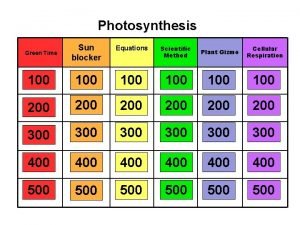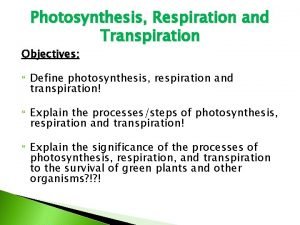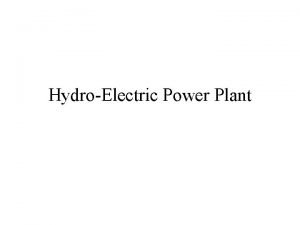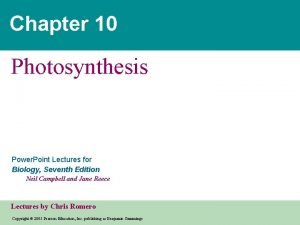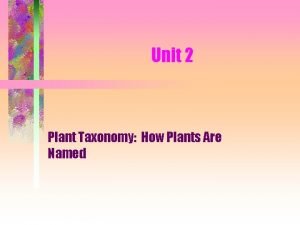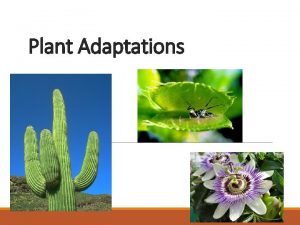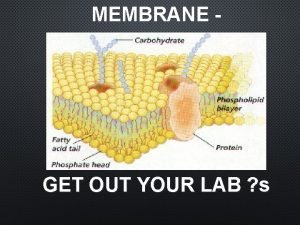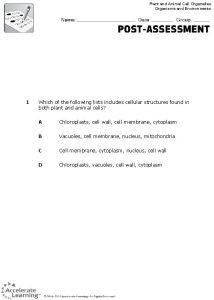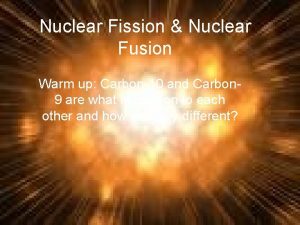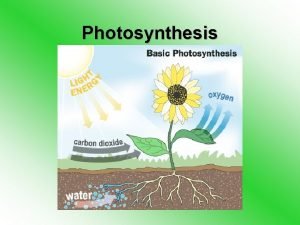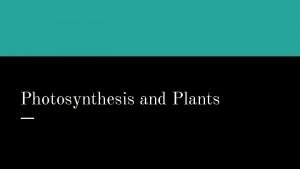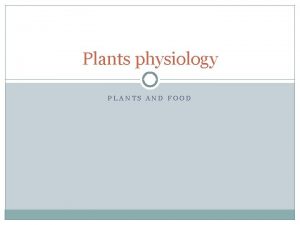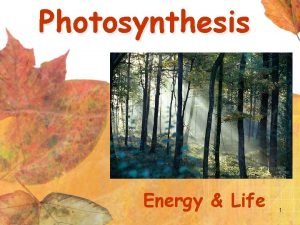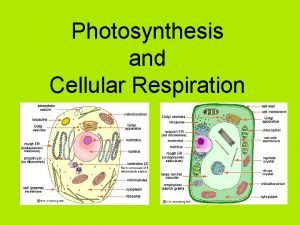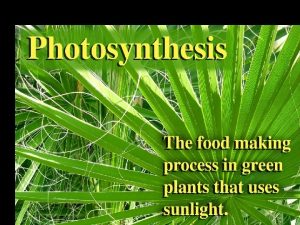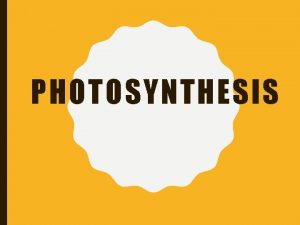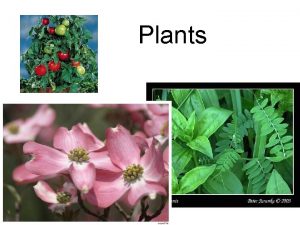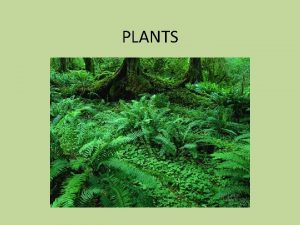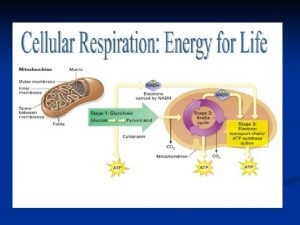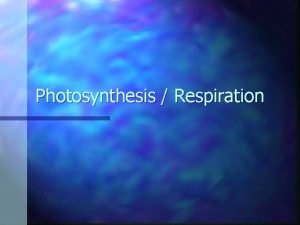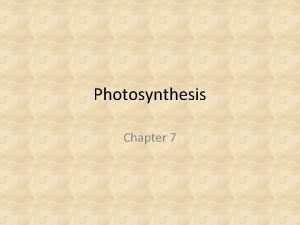Plant Power Plant Power Photosynthesis Plants use water


























- Slides: 26

Plant Power

Plant Power Photosynthesis: Plants use water and atmospheric carbon dioxide to produce a simple sugar and liberate oxygen – Earth’s plants produce 160 billion metric tons of sugar each year 6 CO 2 + 6 H 2 O Carbon dioxide Water Copyright © 2009 Pearson Education, Inc. Light energy Photosynthesis C 6 H 12 O 6 + 6 O 2 Glucose Oxygen gas

Autotrophs are the primary producers of the biosphere Autotrophs are living things that are able to make their own food without using organic molecules derived from any other living thing – Photoautotrophs: autotrophs that use the energy of light to produce organic molecules Copyright © 2009 Pearson Education, Inc.

Photosynthesis occurs in chloroplasts in plant cells Leaf Cross Section Leaf Chloroplasts are the major sites of photosynthesis in green plants Chloroplasts are concentrated in the cells of the mesophyll, the green tissue in the interior of the leaf Stomata are tiny pores in the leaf that allow carbon dioxide to enter and oxygen to exit Copyright © 2009 Pearson Education, Inc. Mesophyll Vein CO 2 Stoma Mesophyll Cell Chloroplast Outer and inner membranes Intermembrane Thylakoid Stroma. Granum Thylakoid space

Chloroplast structure Leaf Cross Section Leaf Mesophyll An envelope of two membranes encloses the stroma, the dense fluid within the chloroplast A system of interconnected membranous sacs called thylakoids segregates the stroma from another compartment, the thylakoid space Copyright © 2009 Pearson Education, Inc. Vein CO 2 Stoma Mesophyll Cell Chloroplast Outer and inner membranes Thylakoid Stroma Granum Thylakoid space Intermembrane space

Where does O 2 gas come from in photosynthesis? Scientists have known for a long time that plants produce O 2 where does it come from? Copyright © 2009 Pearson Education, Inc.

O 2 gas comes from splitting of water Experiment 1 6 CO 2 + 12 H 2 O C 6 H 12 O 6 + 6 H 2 O + 6 O 2 Not labeled Experiment 2 6 CO 2 + 12 H 2 O Reactants: C 6 H 12 O 6 + 6 H 2 O + 6 O 2 Labeled 6 CO 2 Products: C 6 H 12 O 6 Copyright © 2009 Pearson Education, Inc. 12 H 2 O 6 O 2

Photosynthesis is a redox process, as is cellular respiration Photosynthesis is a redox process – Oxidation: Water molecules are split apart by oxidation, which means that they lose electrons along with hydrogen ions (H+) – Reduction: CO 2 is reduced to sugar as electrons and hydrogen ions are added to it Reduction 6 CO 2 + 6 H 2 O C 6 H 12 O 6 + 6 O 2 Oxidation Copyright © 2009 Pearson Education, Inc.

CO 2 H 2 O Chloroplast Light NADP+ ADP P LIGHT REACTIONS CALVIN CYCLE (in stroma) (in thylakoids) ATP NADPH O 2 Sugar

THE LIGHT REACTIONS: CONVERTING SOLAR ENERGY TO CHEMICAL ENERGY Copyright © 2009 Pearson Education, Inc.

Visible radiation drives the light reactions Sunlight contains energy called electromagnetic energy or radiation – Visible light is only a small part of the electromagnetic spectrum – Electromagnetic energy travels in waves, and the wavelength is the distance between the crests of two adjacent waves Copyright © 2009 Pearson Education, Inc.

Visible radiation drives the light reactions Chlorophyll absorbs some wavelengths of light and transmit others Light Reflected light Chloroplast Thylakoid Copyright © 2009 Pearson Education, Inc. Absorbed light Transmitted light

Visible radiation drives the light reactions Chloroplasts contain several different pigments and all absorb light of different wavelengths – Chlorophyll a absorbs blue violet and red light and reflects green – Chlorophyll b absorbs blue and orange and reflects yellow-green – Carotenoids absorb mainly blue-green light and reflect yellow and orange So why are plants usually green? Copyright © 2009 Pearson Education, Inc.

Photosystems capture solar power Ø Ø Chlorophyll absorbs light energy (photons)- cause electrons to jump to higher energy level The electrons drop back down to their “ground state, ” and, as they do, release their excess energy e– Excited state Heat Photon (fluorescence) Ground state Copyright © 2009 Pearson Education, Inc. Chlorophyll molecule

e– ATP e– e– e– NADPH e– P 700 P 680 Photo Mill makes ATP n e– Photosystem II Photosystem I

Photosystems capture solar power The energy released could be lost as heat or light, but rather it is conserved as it is passed from one molecule to another molecule – Photosystems are light-harvesting complexes surrounding a reaction center complex – Photosystem I absorbs wavelenghts of 700 nm – Photosystem II absorbs wavelengths of 680 nm Copyright © 2009 Pearson Education, Inc.

Summary of two photosystems During the light reactions, light energy is transformed into the chemical energy of ATP and NADPH – To accomplish this, electrons removed from water pass from photosystem II to photosystem I and are accepted by NADP+ – The bridge between photosystems II and I is an electron transport chain that provides energy for the synthesis of ATP through chemiosmosis Copyright © 2009 Pearson Education, Inc.

Photon Photosystem II Stroma Electron transport chain Provides energy for synthesis of ATP by chemiosmosis NADP+ + H+ Photon Photosystem I 1 Primary acceptor 2 e– Thylakoid membrane e– 4 P 700 P 680 Thylakoid space 3 H 2 O 1 2 5 O 2 + 2 H+ 6 NADPH

Chloroplast Stroma (low H+ concentration) Light H+ NADP+ + H+ ADP + P NADPH H+ ATP H+ Thylakoid membrane H 2 O 1 2 O 2 + 2 H+ H+ Photosystem II Electron transport chain Thylakoid space (high H+ concentration) H+ H+ H+ Photosystem I H+ H+ ATP synthase

TOTAL OUTCOME OF LIGHT REACTIONS: Light energy is converted to chemical energy and O 2 1. Water is split to provide the O 2 , H+ ions and electrons 2. H+ ions and electrons reduce NADP+ to NADPH, 3. Generation of ATP through chemiosmosis PHOTOPHOSPHORYLATION

THE CALVIN CYCLE: CONVERTING CO 2 TO SUGARS Copyright © 2009 Pearson Education, Inc.

ATP and NADPH are used to make sugar in the Calvin cycle The Calvin cycle makes sugar within a chloroplast Input – CO 2, ATP, and NADPH glyceraldehyde-3 -phosphate (G 3 P) CO 2 ATP NADPH CALVIN – Process called carbon fixation CYCLE – G 3 P makes other sugars Output: Copyright © 2009 Pearson Education, Inc. G 3 P

Why are photosynthetic organisms producers? Copyright © 2009 Pearson Education, Inc.

Why are photosynthetic organisms producers? ◦ Plants make more food than they actually need and stockpile it as starch in roots, tubers, and fruit ◦ Together with photosynthetic algae and bacteria they are primary producers ◦ We are defined as _________ H 2 O Light CO 2 Chloroplast NADP+ ADP + P Photosystem II Electron transport Thylakoid chains membranes Photosystem I Ru. BP CALVIN 3 -PGA (in. CYCLE stroma) ATP NADPH O 2 LIGHT REACTIONS Copyright © 2009 Pearson Education, Inc. Stroma G 3 P Sugars CALVIN CYCLE Cellular respiration Cellulose Starch Other organic compounds

The greenhouse effect – Gases in the atmosphere (often called greenhouse gases), including CO 2, reflect heat back to Earth, keeping the planet warm and supporting life – As we increase the level of greenhouse gases, Earth’s temperature rises above normal (question: correlative or causative? ) Some heat energy escapes into space Sunlight Atmosphere Radiant heat trapped by CO 2 and other gases Copyright © 2009 Pearson Education, Inc.

Global warming… hypothesis or theory? Increasing concentrations of greenhouse gases could be leading to global warming, a slow but steady rise in Earth’s surface temperature – The consequences of continued rise will be melting of polar ice, changing weather patterns, and spread of tropical disease – But is this happening? Is it part of the normal cyclical pattern of the earth? Copyright © 2009 Pearson Education, Inc.
 Water and water and water water
Water and water and water water The food that plants produce during photosynthesis is
The food that plants produce during photosynthesis is What is the word equation of photosynthesis
What is the word equation of photosynthesis Photosynthesis definition
Photosynthesis definition Green plants make their own food by photosynthesis
Green plants make their own food by photosynthesis Reproduce by spores
Reproduce by spores Vascular plants vs nonvascular plants
Vascular plants vs nonvascular plants Non flowering plants classification
Non flowering plants classification C3 plants vs c4 plants
C3 plants vs c4 plants Plant
Plant Chemical equation for cellular respiration
Chemical equation for cellular respiration Photosynthesis power point
Photosynthesis power point Unit 2 plant taxonomy how plants are named
Unit 2 plant taxonomy how plants are named Water balance in plants
Water balance in plants If you don't water the plants they die
If you don't water the plants they die Clareville water treatment plant
Clareville water treatment plant Water potential in plants
Water potential in plants Adaptation of water plants
Adaptation of water plants Cytolysis and plasmolysis
Cytolysis and plasmolysis Animal cells
Animal cells Nitrogen source example
Nitrogen source example Real power and reactive power
Real power and reactive power Who discovered uranium
Who discovered uranium Plant introduction
Plant introduction Plant introduction in plant breeding
Plant introduction in plant breeding Plant introduction in plant breeding
Plant introduction in plant breeding Tronsmo plant pathology and plant diseases download
Tronsmo plant pathology and plant diseases download

